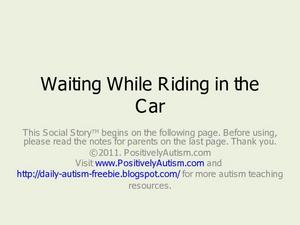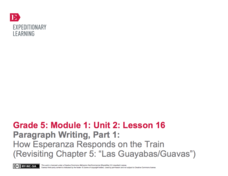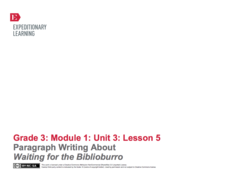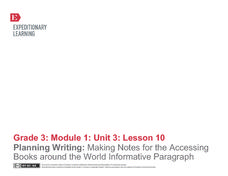K12 Reader
Subject Pronouns Worksheet Two
How well do your pupils know subject pronouns? Provide some practice with this straightforward worksheet. For 18 sentences, individuals circle the subject pronouns. A brief definition of subject pronouns and a list of subject pronouns...
K12 Reader
Demonstrative Pronouns
Ask your pupils to demonstrate their understanding of demonstrative pronouns by completing this activity. There are two parts to the exercise. First, learners identify the pronouns in sentences, and then they complete a short series of...
Grammar Net
Prepositions
Add a worksheet about prepositions and context clues to your grammar unit. As kids read 20 sentences, they fill in the blanks based on what they read and the prepositions that fit the best.
Curated OER
Metaphor Meanings
Help your young writers decipher the literal meanings of metaphors. After reading several metaphors, learners write the real meanings that the phrases are describing. Use this resource in a figurative language lesson, or when preparing...
Curated OER
Poems
Thud! Squiff! Create sound effects with words. Introduce your youngsters to onomatopoeia with these fun, rainy-day poems. They write down sound words, discussing rhythm and rhyme. You can also incorporate the author's use of capital...
Positively Autism
Waiting While Riding in the Car
Traffic and stop lights can be a bother for even the most patient person, but when you have autism, that extra time spent in a hot car can be a real nuisance. Here is a great story that addresses the need to be patient while waiting or...
Curated OER
Subject/ Predicate
It's your basic subject/ predicate identification activity here. Perfect for middle schoolers reviewing the subject and predicate,. This 13-question activity is straightforward and simple.
Curated OER
Relative Pronouns
What does a relative pronoun have to agree with in a sentence? If you said the its antecedent, you're right! Read the short explanation and study the examples at the top of the page. Then, decide which verb form matches the relative...
Curated OER
Phrases as Fragments
A sentence needs to have a subject and a verb. Although your kids know this, fragments often sneak their way into essays and homework assignments. Give your class a review session with this assignment. First, have them read the...
Southern Nevada Regional Professional Development Program
“Double Double Speak Speak”
Bilateral suborbital hematoma? Call an audible? 404? Have fun with “the twittering or warbling of birds,” or as 14th century French speakers would say, have fun with “jargon.” Groups match specialized jargon with plain speech, decode...
Curated OER
Comma Practice Worksheet 3
Are you teaching the comma rules in your classroom? This resource packet covers several comma rules, gives examples of each, and provides short practice opportunities for your learners. Answers are not included.
EngageNY
Mid-Unit 1 Assessment: Human Rights Vocabulary and Common Prefixes
Here is a mid-unit assessment for a group of lessons studying the Universal Declaration of Human Rights (UDHR). The first half of this instructional activity calls for several forms of review. Your class will review the content of the...
EngageNY
Gathering Evidence and Drafting a Two-Voice Poem (Chapter 13: "Los Duraznos/Peaches")
Begin class with a short comprehension quiz and review and then move into a new genre: two-voice poems. The activity provides information about this type of poetry as well as a video example made by eighth graders that you can show your...
EngageNY
Revisiting Big Metaphors and Themes: Revising and Beginning to Perform Two-Voice Poems
Now that your class has read all of Esperanza Rising, take the time to tackle big metaphors and themes. Pupils will participate in an activity called Chalk Talk, in which they circulate around the room in small groups and add comments to...
EngageNY
Paragraph Writing, Part 1: How Esperanza Responds on the Train (Revisiting Chapter 5: "Las Guayabas/Guavas")
When your class members have completed the novel Esperanza Rising, they will be ready to write an expository essay on how Esperanza responds to events and what this says about her character. Set your pupils up for success by starting out...
University of Arizona
Fusing Firecrackers with Narrative
Improve your youngsters' descriptive writing. They study an object and write about what they see as a warm-up, then they read an excerpt from Paul Guest's memoir, One More Theory about Happiness. The next part of the activity prompts...
National Center for Case Study Teaching in Science
A Strange Fish Indeed
Communication is one of the most important aspects of science. In a two-day activity, your high school or college-level biologists will read excerpts from a fictional diary of Marjorie Courtenay-Latimer, the woman who discovered the...
EngageNY
Paragraph Writing About Waiting for the Biblioburro
Ask your learners to synthesize what they know about Waiting for the Biblioburro by writing a well-organized paragraph. Young writers focus on using transition words and including specific details in their paragraphs. The plan allows for...
EngageNY
Planning Writing: Making Notes for the Accessing Books Around the World Informative Paragraph
Encourage your young writers to thoughtfully plan and organize their work. First, model how this is done and vocalize your thought process as you work. Next, create a class list of strategies that they can use during independent writing...
Curated OER
More and Less Handfuls
Working as a pair, two kindergartners will sit at a table and will pick two handfuls of counters. They will combine their individual handfuls into one, and count their own selection. They will then draw and record their count on a record...
Google
Beginner 3: Narrowing a Search to Get the Best Results
Uncover new or more relevant information with the filtering tools in the top navigation bar. First, show your class the tools and demonstrate how to use a few. Next, give class members some time to apply what they have learned. They can...
Polar Trec
Swan Savvy
Just like so many other birds, swans migrate during the cold winter months. Your class can gain a better understanding of migration and bird life as they act out some of the activities common to the tundra swan. They make a nest, sit on...
Baylor College
Do Plants Need Light?
Turn your classroom into a greenhouse with a lesson on plant growth. First, investigate the different parts of seeds, identifying the seed coat, cotyledon, and embryo. Then plant the seeds and watch them grow! Measure the new plants...
Baylor College
Plant or Animal?
Teach your class about the necessities of life using the book Tillena Lou's Day in the Sun. After a teacher-read-aloud, students make puppets depicting different plants and animals from the story and illustrating the habitat in which...

























